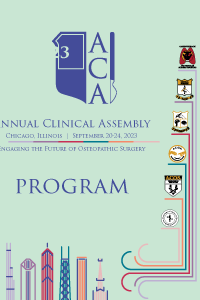General Surgery
Strategies for Building Surgical Capacity in LMICs: A Scoping Review
- tN
thuy-Linh L. Nguyen
Liberty University College of Osteopathic Medicine
Cooper City, Florida, United States
Primary Presenter(s)
After the 2015 Lancet Commission on Global Surgery, efforts have increased to strengthen the capacity of local healthcare systems in low and middle-income countries (LMICs) for surgery. Some of these efforts include educational outreach trips to LMICs, training program development, and construction of new surgical centers. However, there is a lack of coordinated measurement of these methods’ ability to build capacity, especially with the new healthcare technological innovations due to the COVID-19 pandemic. A literature review was conducted to evaluate how capacity building in global surgery is characterized in literature, what methods are being utilized for capacity building, and how equitable this literature is in terms of authorship.
Methods or Case Description:
PubMed was utilized to search for publications between January 2013 and January 2023 with the terms “surgery” and “capacity building” in the title, abstract, or key words. Using these two search terms, 398 articles from PubMed were captured and qualified for data extraction. Exclusion criteria included editorials, non-surgical focus, and non-capacity building focus. Inclusion criteria included all study types except for systematic reviews and guidelines referring to capacity building activities. After application of these criteria, 247 articles were included in the final analysis.
Variables extracted from the search results include geographic scope, methods of capacity building, usage of telehealth or other online tools, surgical specialty, and authorship metrics. Surgical specialty refers to the 14 surgical specialties recognized by the American College of Surgeons. Authorship was evaluated on the basis of first and last authors. The usage of “online tools” refers to methods utilizing the internet that are used for capacity-building such as virtual reality training, online simulations, online educational modules, virtual internships, social discussion forms, and more.
Outcomes:
The top three methods used for capacity building were short-term educational programs (64.6%), partnerships with local governments and organizations (63.1%), and resource & task shifting (41.5%). 48% of publications indicated usage of telehealth or other online tools for capacity building. The most investigated geographic regions were Sub-Saharan Africa (27.5%), Southeast Asia (20.3%), and Central America (8.7%). 34.8% of publications focused on multiple regions. The top three specialties investigated were plastic surgery (15.7%), orthopaedic surgery (14.3%), and pediatric surgery (12.9%). 87.1% of first authors and 71.4% of last authors were affiliated with institutions in HICs.
Conclusion:
The current literature on capacity building in global surgery is growing and has room for continued growth, particularly in terms of increasing LMIC authorship as well as increasing research on capacity building in LMICs outside of Africa and Southeast Asia. Additional research is needed to critically evaluate the feasibility, effectiveness, appropriateness, and sustainability of each method of capacity building in each LMIC. Furthermore, there is room for more studies on capacity building for several surgical specialties in LMICs. Academic global surgery should continue to empower local LMIC leaders in global surgery by increasing equitable partnerships in global surgery curriculums, research, and capacity-building strategies.

